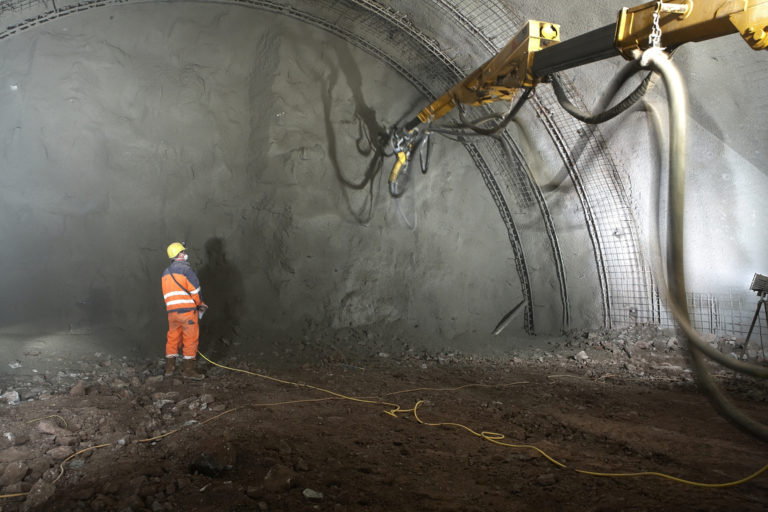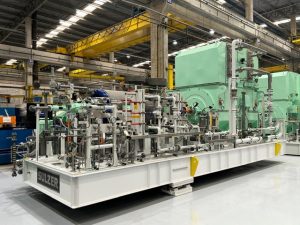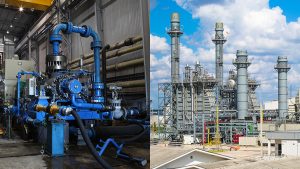Managing Water Pumping Systems in the Most Challenging Construction Projects

Dewatering in German tunnel project. (Image source: Sulzer)
Pablo Garcia, Global Business Development Manager at Sulzer, looks at how tunneling operations can be affected by the choice of pumping equipment used for dewatering.
The advances in tunneling technology in recent years have delivered shorter travelling times as well as safer journeys through mountainous areas and even under the sea. Tunnels can improve transport links, reducing freight costs and making road transport more cost-effective. They also help in the global strategy to reduce CO2 emissions by reducing journey times and opening new railway corridors, which offer a more sustainable solution compared to airfreight.
Taking the decision to construct a tunnel, instead of going over or around an obstruction, is based on many factors, not least the difference in construction costs between the options. However, long-term benefits and improved safety during inclement weather often mean that the tunnel option will be favored.
Water management
From the outset, it is important to understand that water plays a significant role in every tunneling project. Mountain water, groundwater and drilling water all have to be handled properly to maximize the safety as well as efficiency of a project. Water management is a key consideration for all construction sites.
Engineering teams and geologists may have to extract significant volumes of water from the construction site to stabilize the ground or prevent the work area from flooding. As the build progresses, so the distance that the water has to be pumped will increase and this can affect the design of the pumping system.
However, the greatest challenge is water contamination. Solids suspended in the water need to be removed and the pumps that are transferring the water to the treatment plants must be designed to handle the increased abrasion. Similarly, as the depth of the tunnel increases, so the performance, or head, delivered by the pumps must increase.
Construction methods
Although tunnel boring machines (TBMs) are commonly used for larger projects, the drilling and blasting technique is also used to remove materials and create the new tunnel structures. In both situations water is used for cooling the machinery, mixing with the waste materials in the process and needs to be continuously pumped away to the surface.
The proportion of solids in the water can vary considerably and collection tanks may be used along the length of the tunnel to allow some of the solids to settle out. This reduces the solids loading on the pumps and can improve their reliability.
This can be especially beneficial when the local geology includes highly abrasive particles, such as granite. In addition, the construction method can also affect the levels of water contamination. Sprayed concrete residuals can add to the particulate loading of the water, whereas the installation of precast concrete sections will have a minimal effect.
Tunnel design
Shallow tunnels, typically installed in urban environments, normally use a variety of submersible drainage pumps and sludge pumps to transport the water away from the worksite. These can be grouped together at pumping stations that are installed at regular intervals as the length of the tunnel increases.
Depending on the solids content, pumping stations can be designed with settlement tanks that remove sediment or mixers, which keep the solids in suspension, ensuring the sludge pumps perform reliably. In most cases, the pumps will be arranged with some redundancy so that any maintenance issues do not impede progress. Standby pumps can be employed as a back-up or to rotate the duty cycle and extend the service life of the pumping station.
Pump selection
Submersible drainage pumps are designed for water with a low solids content. Sludge pumps operate reliably with water containing low volumes of solids while slurry pumps can tolerate mud mixtures with up to 70% solids. Making the correct choice of pump for each application is essential for continued reliability.
The performance requirements for pumps in tunneling applications are varied. While slurry pumps can operate at low to medium heads, the high-pressure pump designs required for deeper applications are prone to rapid wear if used with heavily contaminated water.
Pump design and the careful selection of materials are crucial to long-term reliability, especially in dewatering applications. High-performance bearings can stay in service for more than 50’000 hours and a pump’s mean time between repair (MTBR) can be as long as one year. Selecting a less suitable pump may result in repairs after just a few weeks.
Efficiency
Most tunnel construction schemes are long-term projects so the cost of ownership of assets used in the build is an important aspect to consider. In terms of the pumps, the combination of hydraulic and electrical efficiency can have a significant effect on the running costs of the pumping stations.
Using advanced liquid-flow modelling techniques and finite element analysis have resulted in optimized hydraulics and specialized coatings that enhance efficiency and keep erosion as well as corrosion to a minimum. Coupled with high efficiency electric motors, the combination of lower running costs and extended reliability offers long-term cost savings for the project.
These savings all help to minimize the life cycle costs of the assets. These are comprised of the initial purchase price, installation and commissioning, energy costs, maintenance and repair expenses as well as the cost of downtime in terms of lost production. As such, it is clear to see how optimized reliability and efficiency can reduce lifetime costs significantly.
Expert support
As with any rotating equipment, support from the manufacturer is essential, for the design of the pumping installation, the selection of the most appropriate pump designs and maintenance support. Onsite assistance with spare parts as well as additional assets to keep pace with the build schedule are equally important.
This process is greatly simplified if the pump supplier has extensive experience in tunneling projects and is organized in such a way that support can be delivered to projects around the world using local facilities.
Sulzer has a broad portfolio of pumping products and mixers that are specifically designed for tunnel dewatering projects. With experienced personnel and flexibility to support this demanding construction environment, Sulzer has the design expertise and manufacturing capabilities to deliver the efficiency as well as reliability that can make all the difference in the construction of a tunnel.
Source: Sulzer Ltd.







